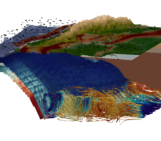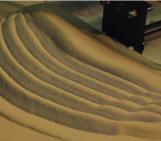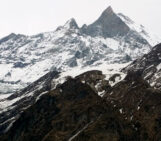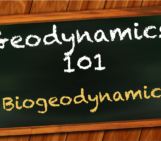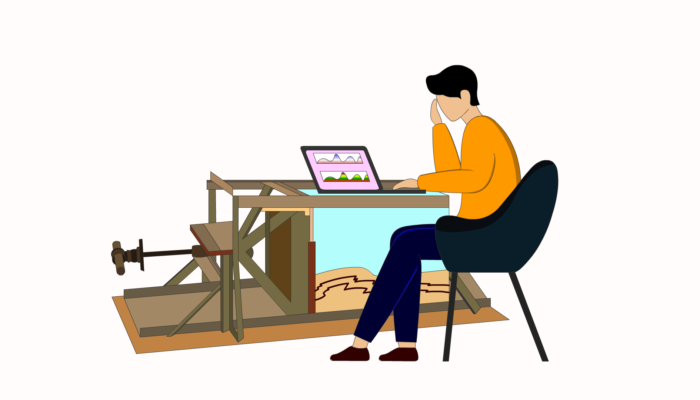
A voyage between different tectonic modelling worlds: from sandbox to supercomputer
On this day after Saint Valentine’s Day, let’s take a moment to talk about the love-hate relationship between analogue and numerical modelling. These two approaches to tectonic modelling may seem different, but they complement each other perfectly, each bringing their own unique strengths. In this blog, Dr. Frank Zwaan shares his journey as he navigates the transition from analogue to numerical modelling and reflects on the beauty of combining the two approaches.
Into the sandbox world
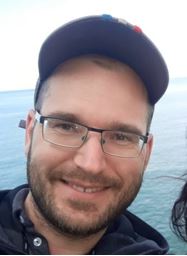
Dr. Frank Zwaan is a postdoctoral researcher at GFZ Potsdam working on the simulation of mantle exhumation during rifting and basin inversion by means of numerical models. In this blog post, he shares his experiences as he navigates the transition from analogue to numerical geodynamic modelling, including any challenges he has encountered along the way.
If my name rings a bell at all, people probably recognise me as that tall (and possibly loud) guy who enjoys putting “sandboxes” in CT-scanners for fun (Fig. 1). It is indeed great fun to play with these “sandboxes”, which are in fact fascinating analogue tectonic models that allow researchers to simulate large-scale tectonic processes that take millions of years to unfold and cover vast areas of the Earth’s surface within a matter of hours or days in a laboratory the size of a living room. Such analogue models provide us with invaluable and direct insights into the dynamics of plate tectonic processes, and allow us to test the influence of different parameters on the evolution of a tectonic system in a unique way. Important challenges in this tectonic modelling endeavour are the choice of the right materials, building a suitable set-up for your specific research question, and the correct application of model scaling. When done correctly, you may be able to see spectacular tectonic features like the Himalayas develop in front of your eyes, especially when making physical cross-sections by cutting the model apart to reveal its internal secrets (Fig. 1b).
.
 (a) (a) |
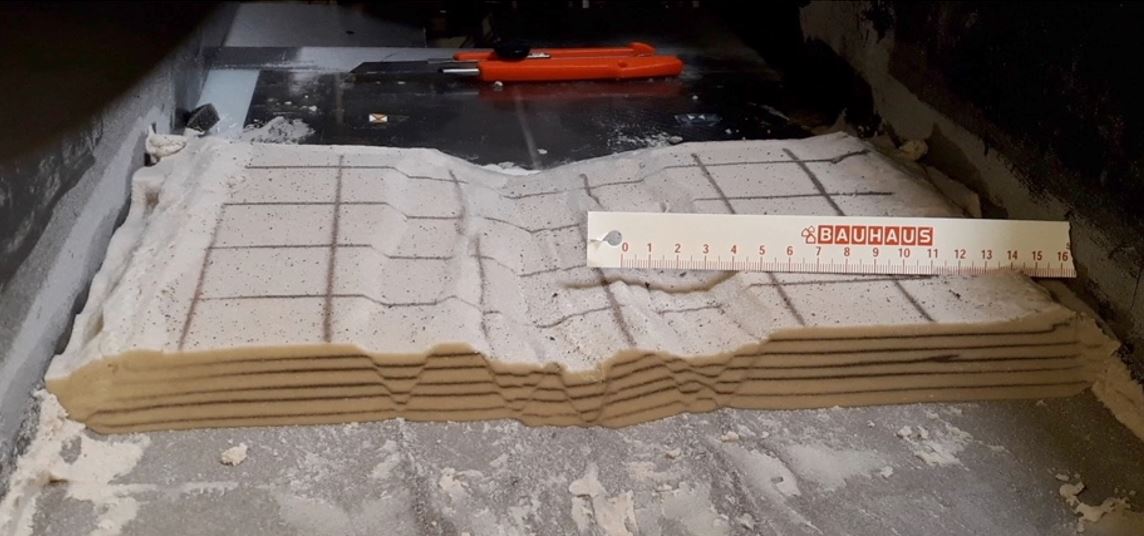 (b) (b) |
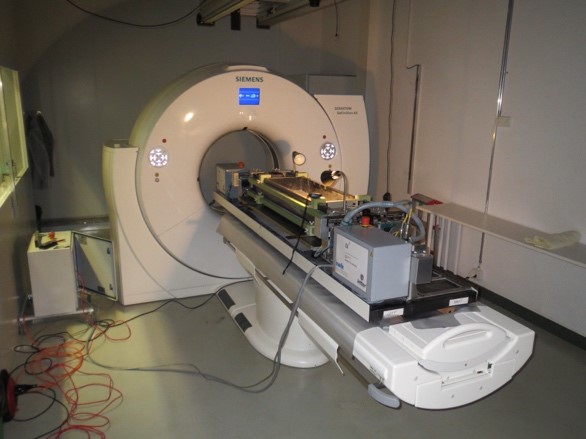 (c) (c) |
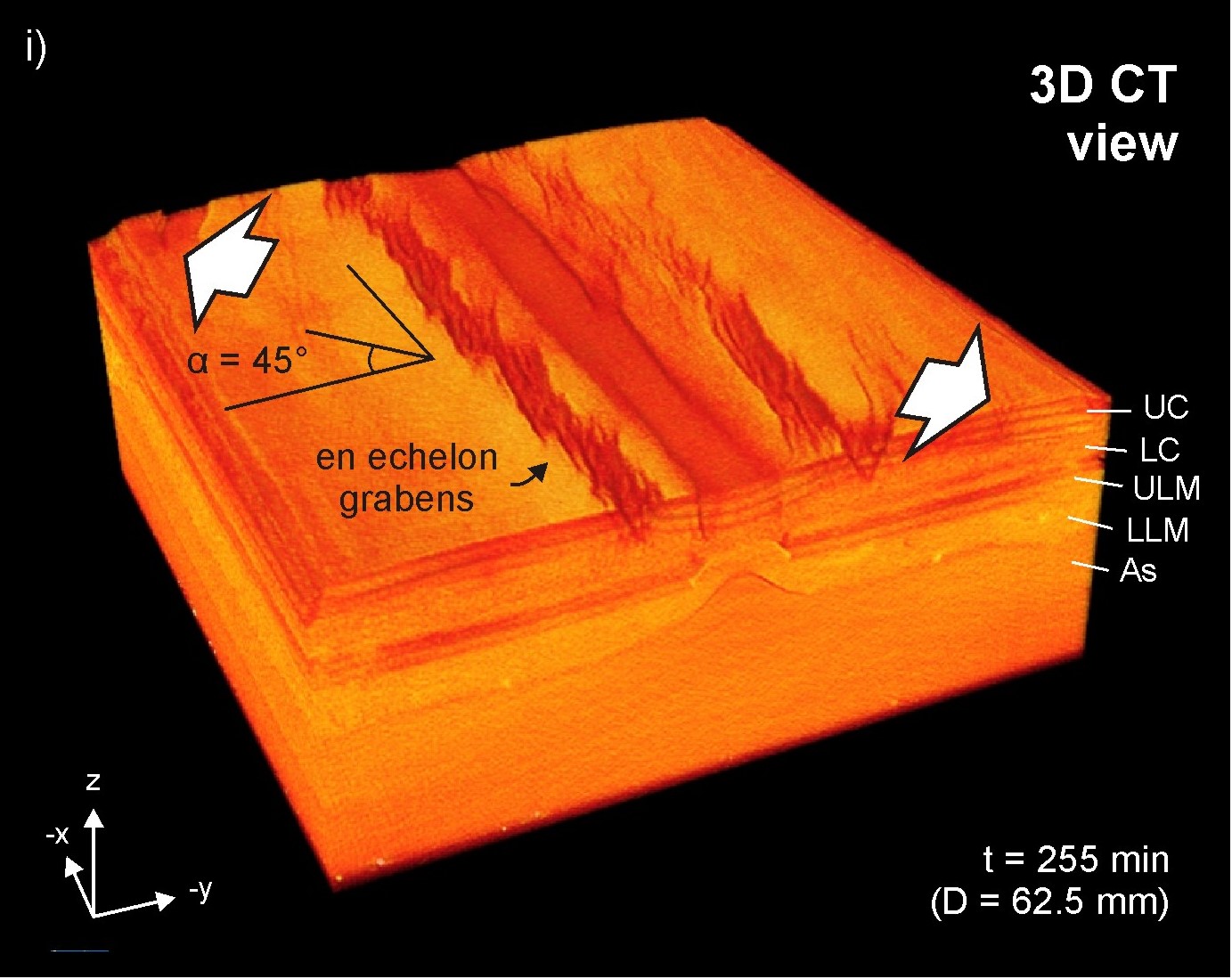 (d) (d) |
Fig. 1. (a) The author of this little novella in his former natural habitat, i.e., the Tectonic Lab University of Bern in Switzerland, explaining the viewer (it’s a still from a short video)* all about the analogue modelling capabilities in Bern. (b) Cross-section of one of the rifting models presented in pane, revealing its internal structures. (c) A model run in the CT-scanner and (d) a 3D depiction of a CT-scanned lithospheric-scale rifting model from a recent study (Zwaan & Schreurs, 2023).
The practical aspects of analogue modelling, where simple materials such as sand and clay combined with some creative tinkering can help us to reveal the mysteries of tectonic systems, has captivated me from the moment I first saw a demonstration at the Vrije Universiteit Amsterdam. Growing up in a small fishing village along the Dutch coast, my childhood involved long days on its sandy beaches. In addition to sailing and fishing on the North Sea’s waves, these days were often spent building sand castles and waterworks to contain the flow of the tides as they swept in and out the gullies and sandbars between the surf and the sandy dunes. Yet, all small boys need to grow up, so I went to study Earth Sciences in Amsterdam (with plenty of fieldwork adventures abroad since the muddy territory of the Netherlands is largely devoid of proper rock outcrops). While keeping a broad interest in anything related to earth sciences, I got fascinated by structural geology and the titanic tectonic processes and massive timescales involved. The revelation that sand can be used to simulate tectonic processes has inspired large parts my subsequent scientific career with of a number of cool projects at various tectonic labs throughout Europe.
Drifting to the dark side
At this point, attentive readers may wonder why on Earth I ended up in the Geodynamic Modelling group at GFZ Potsdam. After all, those geodynamic modellers have no proper tectonic laboratory at all! Worse still, they must actively avoid being around such labs, the dusty nature of which being positively detrimental to the computers they use for their “models”! Indeed, these people run numerical tectonic simulations instead, where they just feed some data into a black box they call a “code”, while pretending that the shiny imagery they generate is remotely related to real-world geology!? So, what am I doing on that dark side of the modelling world? Dear reader, allow me to explain!
The preceding paragraph describes the (somewhat exaggerated) views an analogue modeller may have on these numerical modelling “upstarts”. Analogue modelling has after all been around since the dawn of geology as a science, with the first experiments done by the great Sir James Hall in 1815 (Hall, 1815). The methods involved have vastly improved over the centuries, evolving from a qualitative to a highly quantitative approach though the use of techniques such as (surface) strain analysis on time lapse imagery, topography reconstruction from stereoscopic pictures, CT-scanning, and keeps on providing us with exciting new insights. By contrast, computer modellers are rather new on the block, using numerical codes to directly calculate physical processes. Even so, the results derived from numerical modelling can be directly plotted and are truly impressive. An honest observer must (hesitantly) admit that numerical models are in a number of cases superior to the good old analogue models.
As an analogue modeller, I am well-aware of the strengths and limitations of our methods. For instance, analogue models are great for studying detailed fault evolution and are highly intuitive as you can see them and literally touch them, making them excellent for both high-end research and general teaching / public outreach purposes. However, analogue modellers face major challenges when trying to incorporate factors such as thermal effects, phase changes and surface processes and their models are generally less suitable for large-scale (lithospheric-scale) modelling. Such factors are however much more easily incorporated into numerical models, which are overall better adapted to large-scale processes as well. Yet, numerical models have some drawbacks such as the relatively low model resolution, high costs of simulating tectonics in 3D and the trust one must have in the numerical code, all issues that do not apply in analogue models. As such, we need to understand that although analogue and numerical models have significant overlap in applicability, both approaches have their specific strengths and weaknesses. Combining these approaches to get the best of both worlds would be the way forward, but unfortunately there are only few researchers who have a good grasp on both sides of the “tectonic modelling divide”. Thus, learning more about numerical modelling was a major reason for me to join the geodynamicists at GFZ Potsdam.
Into the world of the supercomputer
About a year ago left behind the cosy lab at the University of Bern located in the hilly foreland of the glorious Swiss Alps for Potsdam in the middle of the flat and windy North German Plain. I was lucky enough to have been awarded a GFZ Discovery Fellowship for a project on mantle exhumation during rifting and subsequent basin inversion, and was ready to kick off on my numerical modelling voyage. And so far it has been quite a voyage indeed!
Next to the challenges of once more moving to a new country (amidst the ongoing covid pandemic), I quickly realised my relative lack of computer skills and had to scramble in a determined attempt to catch up. Indeed, it may be that most analogue modellers are basically structural geologists by trade, who somewhat lost their way and ended up in a dusty tectonic lab (while still feeling the need for fieldwork and hammering rocks)**. By contrast, numerical modellers seem to bring with them a much stronger technical and/or IT background, and tend to have somewhat more sophisticated wardrobe as they do not have to worry about getting dirty in lab or field. This “tectonic modelling divide” may indeed reflect an interesting difference in character between both these groups who I am probably simultaneously offending right now…
Apart from me trying to patch up my computer skills, I also had to rearrange my deepest modelling instincts. I found I had no real clue about many practical aspects related to the model code, and it took a long time to “get these into my system”. Unlike working with analogue modelling set-ups, you cannot simply physically intervene by loosening a screw or scraping away some sand, and directly observe the result. Instead, you need to painstakingly program things using mouse and keyboard, filter out typos and errors in the model parameter files. Generating numerical modelling results can take hours or even days after sending the “job” to a supercomputer, before you can download them for visualisation to find out you made an error. Indeed, these days I get a lot less exercise sitting behind a desk, instead of running through the lab carrying bags of sand around and preparing silicone mixtures for the upcoming experiment (Fig. 2). How times change! However, getting some insight into the notorious “black box” that numerical models may seem to be to outsiders is incredibly interesting, especially when you start to see how small details and issue may influence the model results, which is somewhat similar to the issues and boundary effects we may encounter in analogue models. Perhaps it is blasphemous to propose, but analogue and numerical modellers may not be that different after all…?
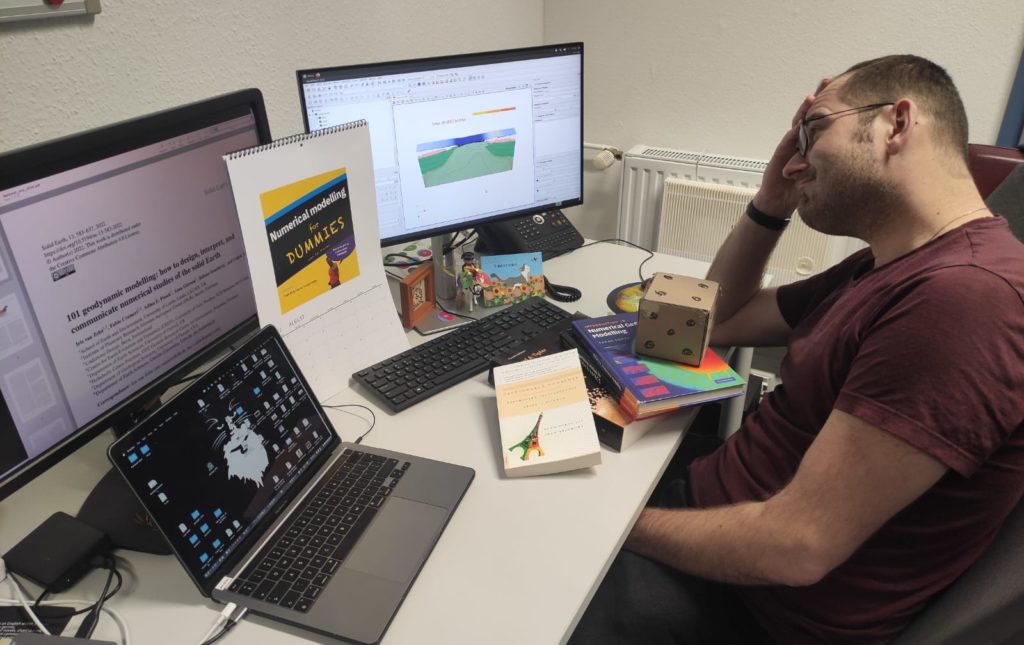 (a) (a) |
 (b) (b) |
Fig. 2. (a) The author of this little novella in his new and still somewhat unfamiliar habitat, i.e., the second floor of Haus A46 on the Albert-Einstein-Straße where the Geodynamic Modelling section of GFZ Potsdam is based, slightly suffering and despairing behind his many screens. (b) Yet, he is slowly but steadily acclimatising to his new surroundings, and is already producing some (at least) nice-looking modelling results of exhuming mantle.
Some final reflections
Trying my hand on numerical modelling also made me realise again that people who are new to analogue modelling probably have very similar issues when they first start working in the lab. As someone with several years of experience I may easily overlook how confusing all the little practical details that I now know by heart can be for a newcomer. As such, this was a highly insightful but also humbling experience: one easily forgets how arduous previous steps in a study or career may have been, making it a challenge to put oneself into another person’s shoes. “I am but an egg” to quote Robert Heinlein’s human envoy from Mars, and “I have still so much to learn” would be a fitting life motto.
Nevertheless, I am greatly enjoying my time at GFZ and I am gradually getting the hang of things. We are now getting some cool modelling results, which I am planning to present at EGU this year. So, keep an eye out! And for those who may fear that I am forever and totally lost to the good old analogue modelling community: please don’t worry, I am still involved in some analogue projects, and I am regularly visiting the outstanding GFZ HelTec lab*** to “touch sand” when the overload of numerical stimuli becomes a bit too much.
The END
Notes * You can watch this ca. 5 min long, semi-professionally produced piece of analogue modeling propaganda on the EPOS Multi-scale Laboratories (MSL) YouTube channel (where also recordings of the MSL seminars are made available): https://www.youtube.com/watch?v=ysb47SDMYTM&list=PLdv1BAYFyLsOtDa5knUhN5pQq6JvwlcGX. More info on the Bern lab can be found here: https://www.geo.unibe.ch/research/tectonics___structural_geology/laboratories/tectonic_modelling_laboratory/index_eng.html ** In fact, it seems that geologists/earth scientists actively distrust computers and electronic gadgets, as students were encouraged to solemnly swear to “never (blindly) trust a computer result” during a lively Saint Barbara Fest at Universität Potsdam. Saint Barbara being the Christian patron saint of those with dangerous trades involving fire and explosives (such as gunsmiths, cannoneers, miners [and by extension geologists]), the earth sciences students at Universität Potsdam organize a yearly feast in her honor. More info on the holy Barbara herself: https://en.wikipedia.org/wiki/Saint_Barbara *** HelTec - Helmholtz Laboratory for Tectonic Modelling: https://www.gfz-potsdam.de/en/section/lithosphere-dynamics/infrastructure/heltec References Hall, J., 1815. II. On the Vertical Position and Convolutions of certain Strata, and their relation with Granite. Earth and Environmental Science Transactions of The Royal Society of Edinburgh 7, 79–108. https://doi.org/10.1017/S0080456800019268 Zwaan, F., & Schreurs, G. (2023). Analogue models of lithospheric-scale rifting monitored in an X-ray CT scanner. Tectonics, 41, e2022TC007291. https://doi.org/10.1029/2022TC007291

